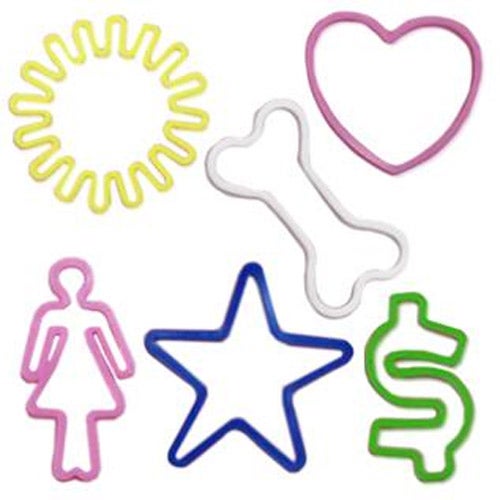Coming soon to a wrist near you... the craze that's sweeping America
The US is in the grip of Silly Bandz fever – and it's set to spread across the Atlantic

Spacehoppers bounced out of Britain's playground almost as quickly as they bounced in; in time, Tamagotchis and the micro scooter also passed into the museum of popular crazes.
But now, for a few months at least, our schoolchildren will soon be wearing, swapping – and probably flicking – novelty elasticated bracelets.
The Silly Bandz bracelets, which have sold millions in the US, have found their way onto the wrists of the Sex and the City actress Sarah Jessica Parker, the model Agyness Deyn, the actress Mary-Kate Olsen, and the fashion designer Henry Holland.
The bracelets, which come in the shape of animals and film characters, stretch when worn on the wrist but snap back to their original shapes when taken off. Sales are worth £63m a year to the American company which produces them, compared with just £6,000 two years ago.
Now British companies are stocking the product. One which has been selling the items since the beginning of July claims they have been their best-selling toy for weeks.
The distributor, which has exclusive rights to distribute them in Britain, is promising to make the bands "available on every high street in the next few weeks". The bands were released in America by a firm called BCP Imports and quickly became popular among children.
Dr Amanda Grum, a psychologist specialising in play and parenting, explained that the main motivation behind the craze is peer pressure.
"This is most effective in children aged five to 12, as they are starting to develop their own identity," she said.
"Most children who succumb to 'crazes' are in the early stages of developing a sense of identity. They are starting to use external features to define themselves. A toy or craze provides a template for their behaviour patterns.
"Belonging is a powerful urge for young children, especially before their sense of self is fully developed," she added. "By aligning themselves with an external force, they are able to use the attributes of that object or group to help define themselves."
Robert Croak, the chief executive officer of BCP Imports, which is based in Ohio, insisted that the bracelets have not been heavily promoted but have taken on an online life of their own.
A Facebook group dedicated to the bands has more than 300,000 members. Children and young teenagers have posted comments and pictures of themselves wearing the bracelets on Facebook as well as on other internet forums. "Everyone asks who my publicist is. I don't have one," said Mr Croak. "We don't advertise. All we do is viral marketing. This is happening on its own."
A rival facebook group, entitled "Some bastard is getting rich off of those damn animal bracelets", has around 100,000 members.
Similar products, manufactured by a Japanese company, were on sale in the US as early as 2002. Mr Croak said he spotted the Japanese products at a trade fair in China around three years ago. He insisted, however, that product was different from his own.
"We trademarked the name. We created them. We created the craze," he insisted.
He told Businessweek magazine: "I liked the way they looked, and I thought if they were done correctly – larger and thicker – they would make a great fashion accessory."
Mr Croak's company has grown in the past year from an office staff of 20 to one of nearly 70 , helped by the host of celebrities being seen to wear his product.
However, a rival company, Forever Collectibles, was able to secure a licensing deal with Disney. It expects to sell 20 million of the packs in the US by the end of the year.
The retailer selling the bracelets in the UK, Firebox, reported selling more than 3,000 bracelets in just over a month and 2,000 in one week alone.
The company's chief executive, Christian Robertson, said he was stocking up on the bracelets in anticipation of high Christmas sales.
"We make around 60 per cent of our turnover in the final quarter of every year and the fact that these products are selling so well now is encouraging," he said.
"It is even a little surprising, given that the children are not at school at the moment," he added. "I think that, given the viral nature of their promotion, they will become even more popular – just in time for Christmas."
Childhood fads...
Space hoppers
Remembered fondly by children of the 1970s, who flung themselves around their homes and garden with joyous abandon. The Space Hopper was one of the original and best-known kids' crazes.
Pogo sticks
Even more precarious than the Space Hopper, the pogo stick came with the perfectly real risk of being skewered. The bouncy metal poles have been used in competitions, weddings and even to set world records.
Pokémon
Built around a trading card game and animated TV series, the cards each display one of the various creatures, their array of abilities and their rarity. Collecting a huge number of cards made a player eligible to enter into battles with other collectors, playing a version of Top Trumps (another classic fad).
Football stickers
The quintessential child's collectible of the 1980s spawned a lively playground trading culture where entire lunchtimes would be consumed with relentless haggle and barter. Each player's sticker varied in value depending on his current popularity. Find a "shiny" and you could expect to wield considerable power.
Join our commenting forum
Join thought-provoking conversations, follow other Independent readers and see their replies
Comments